The American era in the Philippines, spanning from 1898 to 1946, marked a transformative period for music and culture. During this time, the influence of Western composers like Beethoven, Bach, and Mozart played a pivotal role in shaping the local musical landscape. Filipino artists began blending these classical traditions with their own rich heritage, creating a unique fusion that resonated deeply with their identity.
This cultural exchange was further accelerated by the establishment of institutions such as St. Scholastica’s College and the University of the Philippines Conservatory of music. These schools became breeding grounds for talent, nurturing the first generation of Filipino composers who would go on to define the nation’s musical legacy. Figures like Nicanor Abelardo and Francisco Santiago emerged as pioneers, crafting works that reflected both Western techniques and Filipino sensibilities.
As technology and education reforms took hold, the Philippines saw a surge in musical innovation. From the sarswela tradition to the rise of semi-classical instrumental groups, this era laid the foundation for the vibrant music scene we know today. Join us as we explore how this fascinating period shaped the evolution of Filipino music and its enduring impact.
Key Takeaways
- The American era (1898–1946) was a transformative period for Filipino music.
- Western composers like Beethoven and Mozart influenced local musical traditions.
- Institutions like St. Scholastica’s College nurtured the first generation of Filipino composers.
- Cultural exchange between American and Filipino practices enriched the music scene.
- Technological and educational reforms played a key role in fostering musical talent.
Introduction to the American Era in Philippine Music
From 1898 to 1946, the Philippines experienced a musical renaissance under American influence. This period marked a significant shift in the country’s cultural and artistic landscape. The introduction of Western classical music traditions, such as symphonies and concertos, played a pivotal role in shaping Filipino musical identity.
American cultural influences brought new educational methodologies to the Philippines. Institutions like St. Scholastica’s College and the University of the Philippines Conservatory of Music became hubs for nurturing talent. These schools emphasized structured musical education, blending Western techniques with local traditions.
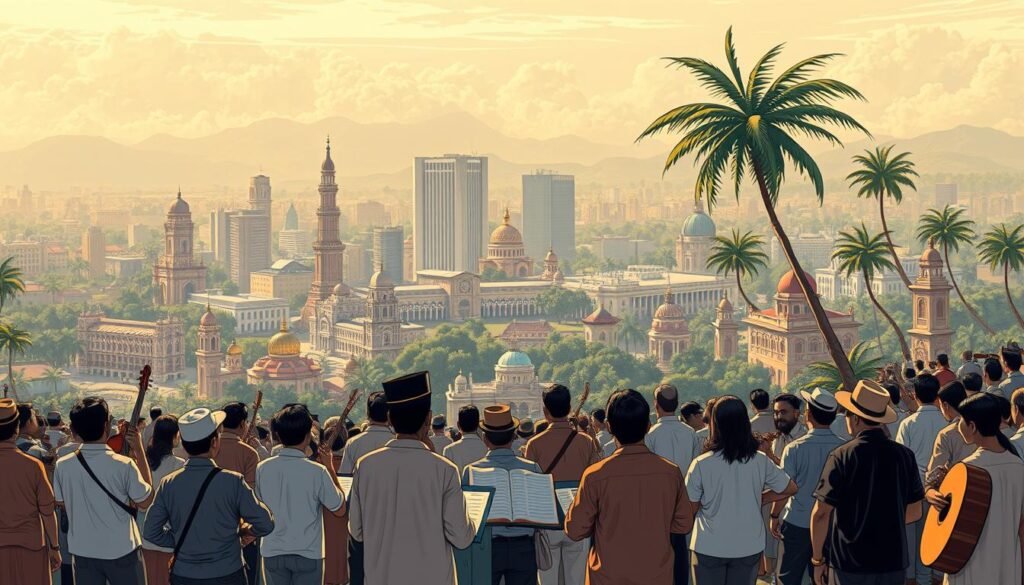
One of the most notable adaptations was the Filipino interpretation of the concerto. This musical form, rooted in Western classical music, was reimagined to reflect Filipino sensibilities. Musicians began incorporating indigenous melodies and rhythms, creating a unique fusion that resonated with audiences.
The American era also saw the rise of structured musical education as part of broader cultural assimilation. This shift not only elevated the quality of musical composition but also fostered a deeper appreciation for classical music among Filipinos. The fusion of Western and local traditions laid the foundation for a vibrant and diverse musical scene.
As we delve deeper into this transformative period, we’ll explore how these changes influenced the evolution of Philippine music. From the adoption of the concerto to the integration of global styles, the American era remains a cornerstone of the nation’s musical heritage.
Historical Context of the American Influence
The American colonial period brought sweeping changes to the Philippines, particularly in the realm of music education and performance. This era saw the introduction of structured musical pedagogy, which transformed local academies and training methods. Institutions like St. Scholastica’s College and the University of the Philippines Conservatory of Music became centers of excellence, blending Western techniques with Filipino traditions.
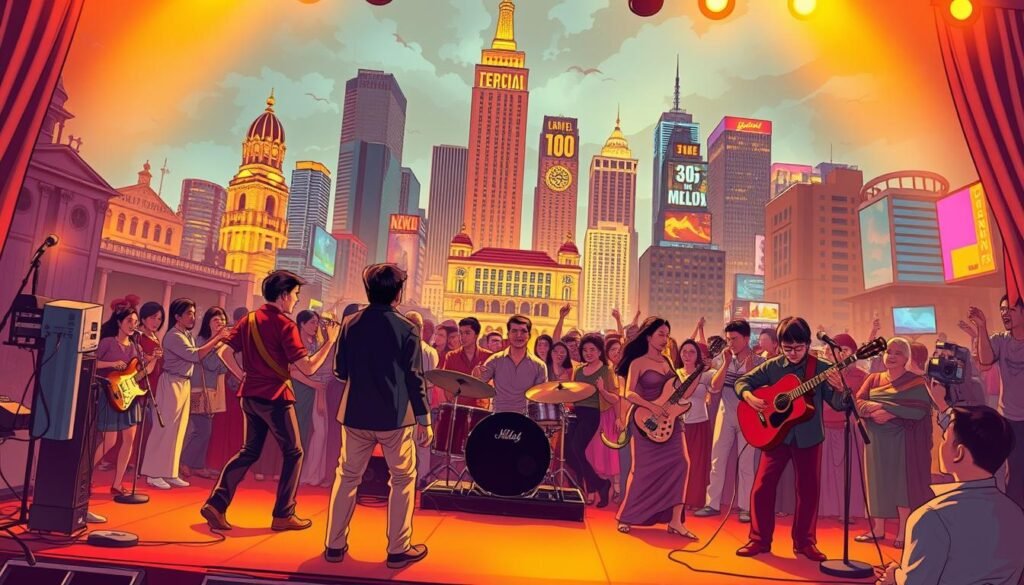
Colonial Educational Reforms
American educational systems emphasized formal training in music, introducing Filipinos to Western opera and symphony. These reforms elevated performance standards and expanded the repertoire of local musicians. For example, the violin became a key instrument in both solo and ensemble performances, bridging Western and Filipino musical styles.
The integration of Western musical principles also led to the creation of hybrid forms. Filipino musicians began incorporating indigenous melodies into classical structures, producing works that resonated with both local and international audiences. This cultural exchange enriched the Philippines’ musical landscape and set the stage for future innovation.
Cultural Syncretism in Music
Cultural syncretism played a vital role in shaping Filipino music during this period. Exposure to European opera and symphony inspired local artists to experiment with new forms and techniques. For instance, traditional Filipino tunes were often adapted into Western frameworks, creating a unique fusion that reflected the nation’s evolving identity.
The interplay between enforced educational standards and traditional expressions fostered a dynamic musical environment. This blend of influences not only preserved Filipino heritage but also introduced new possibilities for artistic exploration. The table below highlights key aspects of this cultural exchange:
| Aspect | Western Influence | Filipino Adaptation |
|---|---|---|
| Training Methods | Structured pedagogy | Blended with local traditions |
| Instruments | Violin, piano | Incorporated into indigenous ensembles |
| Musical Forms | Opera, symphony | Adapted with Filipino melodies |
These changes laid the groundwork for the next era of musical innovation in the Philippines. By embracing both Western and local traditions, Filipino musicians created a rich and diverse musical heritage that continues to inspire today.
Western Classical Music Traditions and Their Legacy
The influence of Western classical music traditions has left an indelible mark on Filipino musical artistry. From the intricate use of string instruments to the intimate settings of chamber music, these traditions have shaped the technical and expressive standards of modern Filipino compositions.
One of the most significant figures in this legacy is Johann Sebastian Bach. Known for his rigorous weekly cantata compositions, Bach’s work exemplifies the discipline and creativity that Filipino musicians admire. His structured approach to harmony and melody has inspired local artists to blend Western techniques with indigenous rhythms.
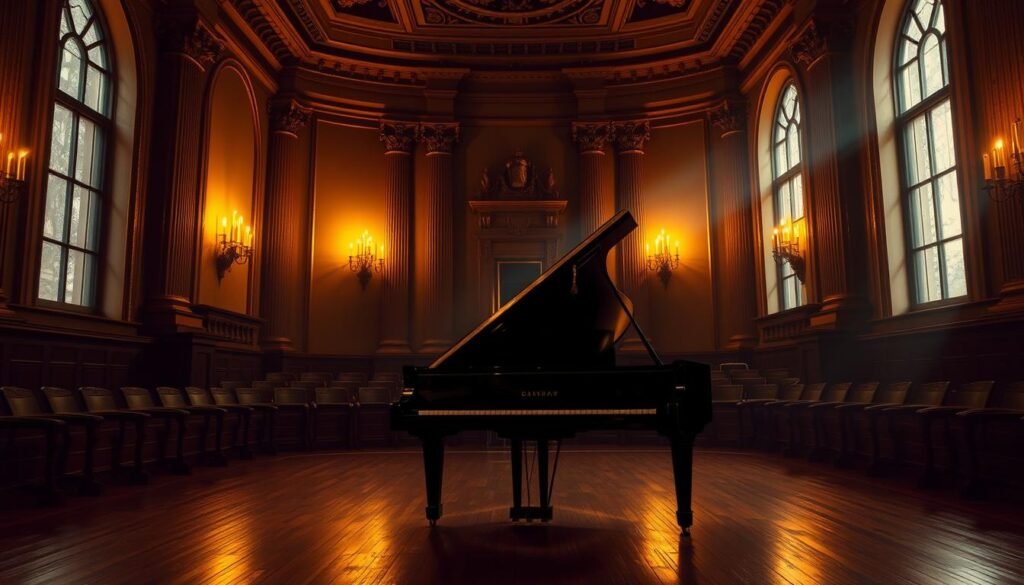
Chamber music, with its focus on small ensembles, has also played a vital role in Filipino music. This format allows for a more personal and expressive performance, fostering a deeper connection between musicians and audiences. Filipino artists have embraced this tradition, creating works that reflect both global influences and local sensibilities.
The integration of Western classical traditions into Filipino music has not only elevated technical standards but also enriched the nation’s cultural identity. As one musician noted,
“The fusion of Western and Filipino elements creates a unique sound that resonates with our heritage and aspirations.”
Today, the legacy of Johann Sebastian Bach and the enduring appeal of chamber music continue to inspire Filipino musicians. These traditions serve as a foundation for innovation, ensuring that the Philippines remains a vibrant hub of musical creativity.
Integration of Global Musical Styles in Filipino Composition
The fusion of global musical styles with Filipino traditions created a vibrant and innovative artistic movement. Filipino artists began incorporating techniques from around the world, enriching their work with diverse influences. One of the most significant contributions came from German theatrical compositions, particularly ballet, which introduced new forms of storytelling through music and movement.
European choreographic influences played a key role in transforming traditional Filipino pieces. The structured narratives of ballet provided a framework for blending local melodies with Western classical forms. This integration allowed Filipino artists to explore new creative possibilities while preserving their cultural identity.

One notable example is the adaptation of German ballet techniques into Filipino performance art. Works like La Loba Negra and Daragang Magayon showcase how international trends were reinterpreted to reflect local legends and themes. These pieces demonstrate the seamless blending of global and indigenous elements.
The impact of cross-cultural exchanges extended beyond performance. Filipino musicians began experimenting with European instruments and compositional techniques, creating a unique sound that resonated with audiences worldwide. This fusion not only elevated the technical quality of their work but also fostered a deeper appreciation for global musical traditions.
Below is a table highlighting key aspects of this integration:
| Aspect | Global Influence | Filipino Adaptation |
|---|---|---|
| Narrative Structure | German ballet | Local legends and themes |
| Musical Techniques | European classical forms | Indigenous melodies and rhythms |
| Performance Style | Choreographed movements | Traditional Filipino dance |
This blending of styles marked a turning point in Filipino music. By embracing global influences, artists created works that were both innovative and deeply rooted in their heritage. As one musician noted,
“The fusion of global and local elements allows us to tell our stories in a way that connects with the world.”
Today, the legacy of this integration continues to inspire Filipino musicians. The combination of ballet, German theatrical traditions, and indigenous artistry remains a cornerstone of the nation’s musical identity.
Early Pioneers of Filipino Music in a Changing Era
The early 20th century saw Filipino musicians boldly experiment with Western musical forms, laying the foundation for a unique national sound. Figures like Antonio Molina and Francisco Santiago emerged as trailblazers, blending Western techniques with indigenous traditions. Their work reflected a deep commitment to preserving Filipino identity while embracing global influences.
One of the most significant contributions of these pioneers was their adaptation of the mass. This sacred musical form, rooted in Western tradition, was reimagined to incorporate Filipino melodies and rhythms. The result was a fusion that resonated with both local and international audiences, showcasing the versatility of Filipino artistry.
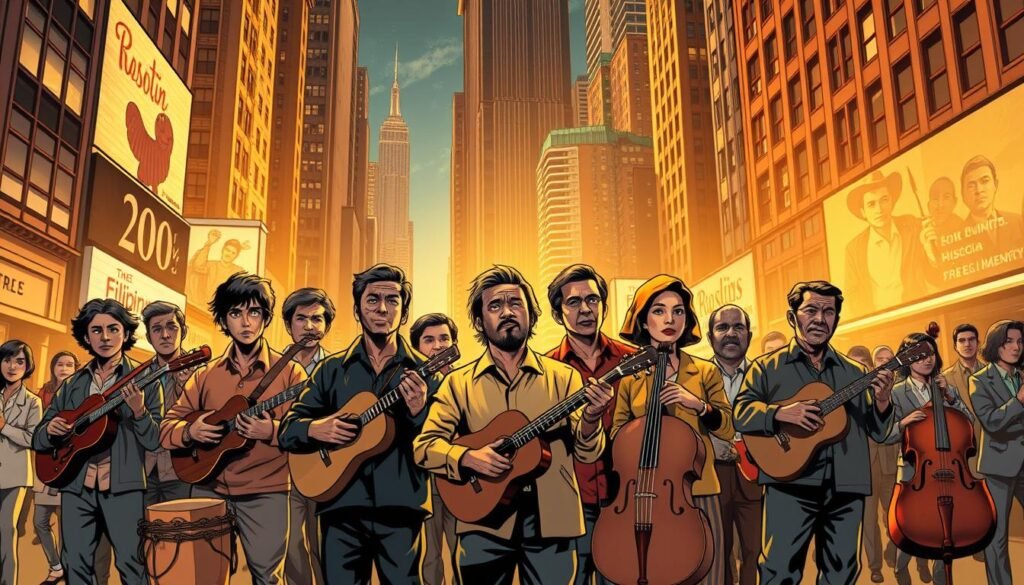
Another key innovation was the use of the minor key in compositions. This tonal choice added emotional depth to Filipino music, allowing artists to explore themes of struggle and resilience. Works like Nicanor Abelardo’s Nasaan Ka Irog? exemplify this approach, blending Western harmonic structures with heartfelt Filipino narratives.
The sonata form also played a pivotal role in shaping Filipino music. Pioneers like Molina embraced this structured format, using it to create works that balanced technical precision with cultural expression. Their compositions often featured indigenous instruments alongside Western ones, creating a rich and diverse soundscape.
Despite limited resources, these early pioneers persevered, driven by a passion for their craft. As one musician noted,
“Our music is a reflection of our history, our struggles, and our dreams.”
Political and educational changes during this period further fueled their creativity. The establishment of music academies and the introduction of formal training provided new opportunities for innovation. These developments not only elevated the quality of Filipino music but also fostered a deeper appreciation for Western structures among local audiences.
Below is a table highlighting key contributions of these pioneers:
| Pioneer | Contribution |
|---|---|
| Antonio Molina | Adaptation of the sonata form |
| Francisco Santiago | Integration of minor key in compositions |
| Nicanor Abelardo | Blending Western and Filipino melodies in the mass |
Their early experimentation paved the way for a broader acceptance of Western musical structures in Filipino music. Today, their legacy continues to inspire new generations of artists, ensuring that the Philippines remains a vibrant hub of musical creativity.
The Impact of American Institutions on Musical Education
The birth of modern music academies in the Philippines was fueled by American educational reforms. These institutions introduced structured teaching methods that transformed the way music was taught and learned. By blending Western techniques with local traditions, they created a foundation for a disciplined approach to composition and performance.
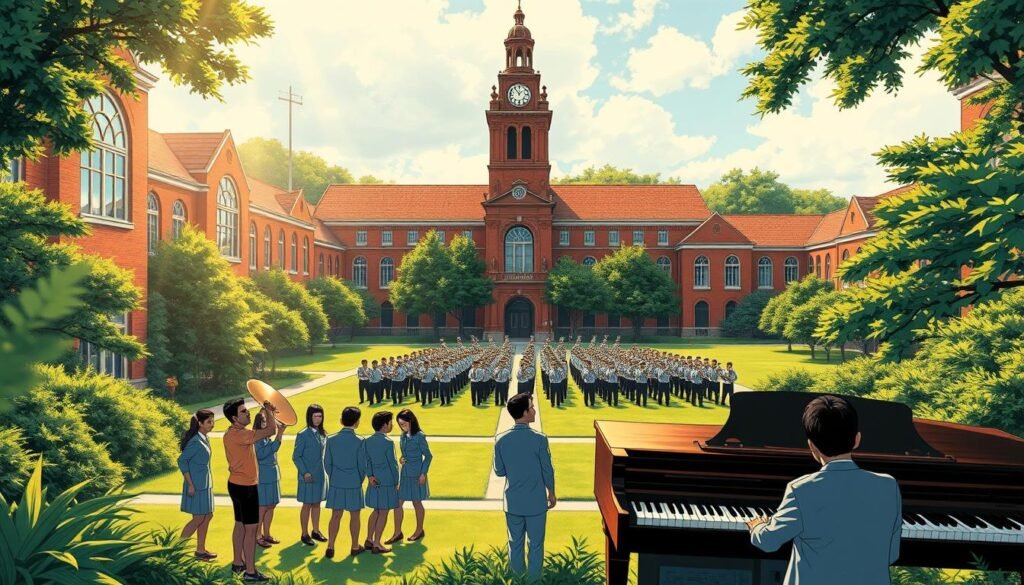
Adoption of New Teaching Methods
American influence brought innovative teaching methods to the Philippines. Schools like St. Scholastica’s College and the University of the Philippines Conservatory of Music adopted structured curricula. These programs emphasized technical skills, theory, and performance, inspiring a new generation of musicians.
One notable example is the influence of Antonio Vivaldi’s teaching methodologies. His focus on precision and creativity became a model for Filipino educators. This approach not only improved technical standards but also encouraged artistic expression.
Formation of Modern Music Academies
The establishment of music academies marked a turning point in Filipino music education. These institutions provided formal training and resources, fostering talent and innovation. They became hubs for cultural exchange, blending global influences with local traditions.
Here’s a brief list of early influential figures who shaped the educational landscape:
- Antonio Molina: Pioneered the integration of Western and Filipino musical styles.
- Francisco Santiago: Advocated for structured pedagogy in music education.
- Nicanor Abelardo: Blended classical techniques with indigenous melodies.
The emergence of these academies led to the birth of innovative educational techniques. Students were exposed to diverse musical styles, from classical to contemporary, enriching their artistic perspectives. As one educator noted,
“Music education is not just about technique; it’s about understanding and expressing our cultural identity.”
Today, the legacy of these institutions continues to inspire Filipino musicians. Their emphasis on discipline, creativity, and cultural preservation ensures that the Philippines remains a vibrant center of musical excellence.
The Role of Cultural Identity in Filipino Composition
The interplay between cultural identity and music became a defining feature of Filipino artistry during the American era. This period saw musicians drawing inspiration from their rich heritage while integrating Western techniques. The result was a unique fusion that celebrated Filipino pride and resilience.
Historical shifts played a crucial role in shaping the aesthetic of local musical suites. For example, the kundiman, a traditional Filipino art song, evolved to express both love and patriotism. Composers like Nicanor Abelardo used this form to weave indigenous melodies into Western harmonic structures, creating works that resonated deeply with audiences.
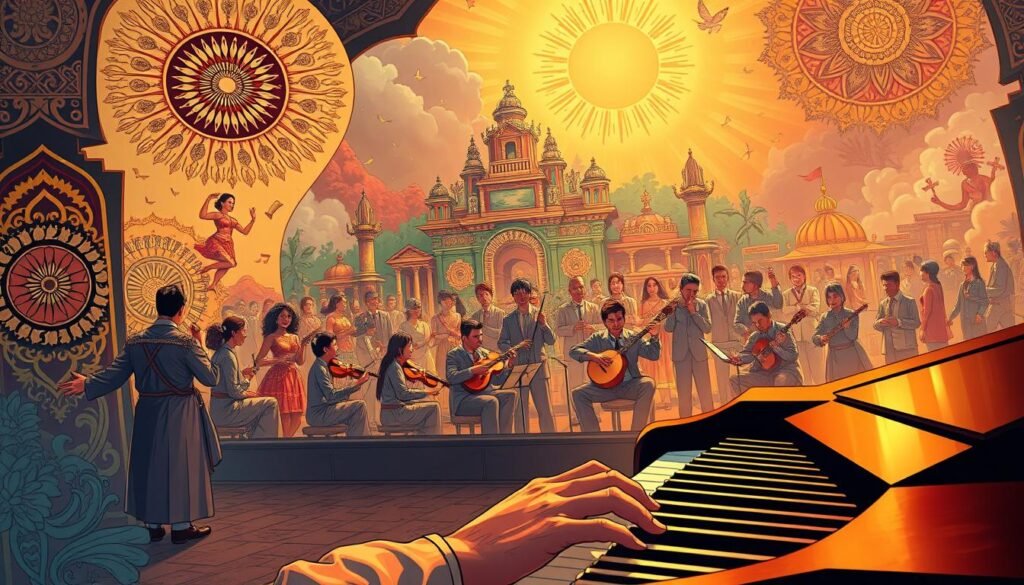
The blending of indigenous motifs with Western composition techniques was a hallmark of this era. Musicians often incorporated local rhythms and instruments into orchestral and suite forms. This approach not only preserved cultural traditions but also introduced them to a global audience.
Cultural pride was a driving force behind many compositions. Works like Francisco Santiago’s Sonata Filipina and Jose Estella’s Filipinas Symphony showcased the nation’s history and aspirations. These pieces used local themes to reaffirm Filipino identity, blending global influences with a distinctly local voice.
Here are some key examples of how cultural identity shaped Filipino music:
- Kundiman ng Himagsikan: Revolutionary songs that expressed love for the country.
- La Loba Negra: A ballet that reimagined local legends through Western choreography.
- Piano Concerto in Bb minor: A blend of classical techniques and Filipino melodies.
As one musician noted,
“Our music is a reflection of who we are—our struggles, our dreams, and our heritage.”
This fusion of cultural identity and musical innovation continues to inspire Filipino artists today. By honoring their history while embracing global trends, they have created a legacy that resonates across generations.
Analysis of Prominent Classical Composers as Influences
The evolution of classical music owes much to the groundbreaking contributions of iconic figures like Beethoven, Bach, and Mozart. Their works not only defined their eras but also laid the foundation for modern musical structures. By blending technical mastery with emotional depth, these composers created timeless pieces that continue to inspire artists worldwide.
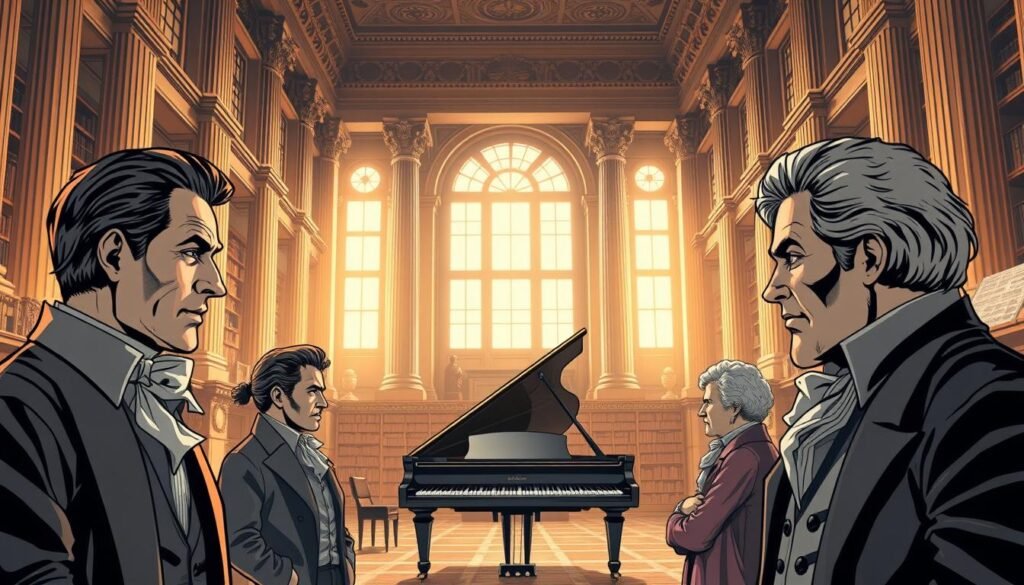
Innovations by Beethoven, Bach, and Mozart
Ludwig van Beethoven’s ability to compose despite near-total deafness showcases his unparalleled dedication. His Third Symphony, the ‘Eroica,’ revolutionized symphonic form with its dynamic thematic development. Similarly, Johann Sebastian Bach’s preludes and fugues remain cornerstones of the baroque era, demonstrating intricate harmonies and technical precision.
Wolfgang Amadeus Mozart’s versatility is evident in his 41 symphonies and 22 operas. His ability to excel in multiple genres set a benchmark for future composers. As one musician noted,
“Mozart’s works are a masterclass in blending structure with emotion.”
Legacy of Romantic and Baroque Eras
The baroque period, epitomized by Bach’s 6 Brandenburg Concertos, emphasized ornate compositions and structured forms. This era’s influence is evident in Filipino adaptations of Western techniques, where local melodies were woven into classical frameworks.
The Romantic era, marked by Beethoven’s emotional intensity, introduced new expressive possibilities. Filipino composers drew inspiration from this period, creating works that reflected both global trends and local identity. The fusion of these eras continues to shape modern compositions, ensuring their relevance across generations.
Bridging Traditional Filipino Melodies with Western Techniques
Filipino musicians skillfully merged indigenous tunes with Western structures to craft a distinct sound. This creative process involved blending traditional melodies, like the kundiman, with refined Western techniques. The result was a harmonious fusion that resonated with both local and global audiences.
The string quartet played a pivotal role in this cultural exchange. Its structured format allowed for the integration of Filipino folk tunes into classical frameworks. This adaptation showcased the versatility of Filipino artistry while preserving its cultural identity.
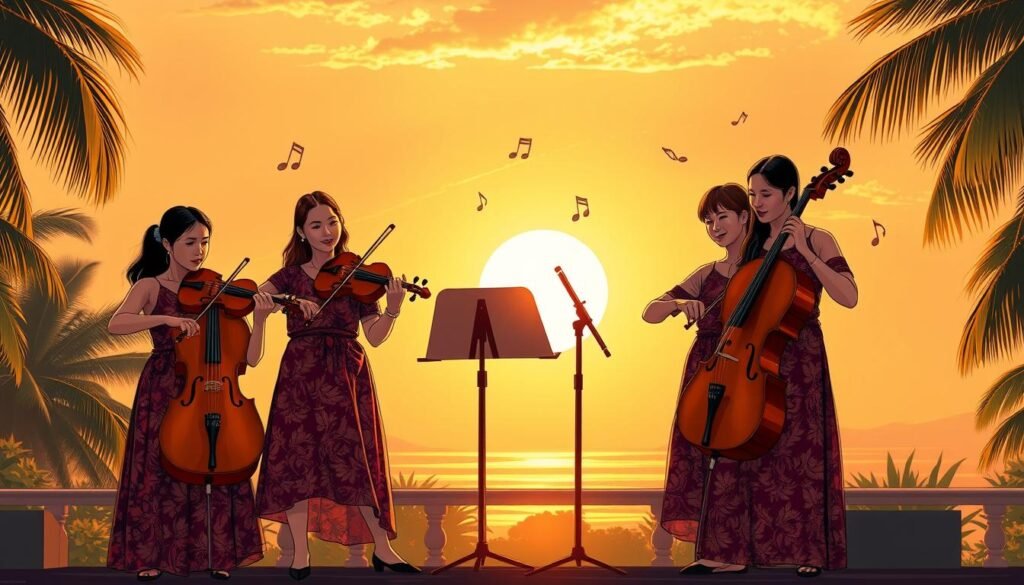
Influences from Czech and Austrian musical practices further enriched this blend. Composers like Franz Schubert inspired Filipino artists to experiment with sophisticated quartet formats. These adaptations often featured indigenous instruments alongside Western ones, creating a rich and diverse soundscape.
One notable example is the adaptation of the string quartet in local compositions. Works like Nicanor Abelardo’s Nasaan Ka Irog? demonstrate how traditional melodies were woven into Western harmonic structures. This approach not only elevated technical standards but also deepened emotional resonance.
Case studies highlight the harmonious coexistence of traditional and Western elements. For instance, the Manila String Quartet’s performances often blend Filipino folk tunes with classical pieces. This fusion has become a hallmark of the nation’s musical identity.
“The blending of global and local elements allows us to tell our stories in a way that connects with the world.”
To learn more about the evolution of Filipino art songs, visit this detailed exploration of their cultural significance.
The Influence of Composers on Filipino Music
The fusion of orchestral and piano traditions from America and Europe reshaped Filipino music during the American era. This period saw the introduction of complex arrangements and sophisticated techniques that became foundational for local compositions. The orchestra, with its rich textures and dynamic range, provided a framework for Filipino musicians to experiment and innovate.
One of the most significant contributions was the adaptation of piano techniques. Filipino artists drew inspiration from renowned American and European works, blending them with indigenous melodies. This cross-cultural exchange enriched the nation’s musical identity, creating a unique sound that resonated globally.
Iconic pieces like Nicanor Abelardo’s Sinfonietta for Strings and Lucresia Kasilag’s Toccata for Percussion exemplify this fusion. These works combined Western structures with Filipino themes, showcasing the versatility of local artistry. The piano, in particular, became a key instrument in both solo and ensemble performances.
The Philippine Philharmonic Orchestra played a pivotal role in this transformation. By performing both classical and contemporary works, it bridged the gap between global and local traditions. This institution became a symbol of the nation’s musical evolution, inspiring a new generation of artists.
Below is a table highlighting key influences and adaptations:
| Influence | Filipino Adaptation |
|---|---|
| Orchestral Arrangements | Blended with indigenous rhythms |
| Piano Techniques | Incorporated into traditional melodies |
| Cross-Cultural Dialogue | Sparked a renaissance in composition |
As one musician noted,
“The fusion of global and local elements allowed us to create music that reflects our heritage and aspirations.”
This blending of traditions continues to inspire Filipino musicians today. By embracing both Western and indigenous influences, they have crafted a legacy that resonates across generations.
Key Musical Forms and Genres: Opera, Symphony, and Concerto
Opera, symphony, and concerto emerged as key musical forms during the American era in the Philippines. These genres became pillars of Filipino musical expression, blending Western techniques with local traditions. Their evolution reflects the cultural exchange that defined this transformative period.
Opera and Stage Works
Opera played a significant role in Filipino music, combining storytelling with orchestral arrangements. Works like La Loba Negra showcased the fusion of Western operatic traditions with Filipino themes. The use of solo performances and chorus elements added depth to these productions.
Opera became a medium for cultural storytelling, reflecting the nation’s history and aspirations. Filipino artists adapted European structures to create works that resonated with local audiences. This blend of global and indigenous elements remains a hallmark of Filipino opera.
Evolution of the Symphony and Concerto
The symphony and concerto evolved significantly during this period. Filipino musicians embraced these forms, integrating indigenous melodies into classical frameworks. The quartet format, in particular, became a popular medium for experimentation.
Works like Nicanor Abelardo’s Sinfonietta for Strings exemplify this fusion. These compositions balanced technical precision with emotional resonance, showcasing the versatility of Filipino artistry. The concerto, with its emphasis on solo performances, also gained prominence.
Below is a table highlighting key adaptations of these genres:
| Genre | Filipino Adaptation |
|---|---|
| Opera | Blended with local legends and themes |
| Symphony | Incorporated indigenous rhythms |
| Concerto | Featured solo performances with orchestral accompaniment |
As one musician noted,
“The fusion of global and local elements allowed us to create music that reflects our heritage and aspirations.”
Today, the legacy of opera, symphony, and concerto continues to inspire Filipino musicians. These genres remain a testament to the nation’s rich musical heritage and its ability to adapt and innovate.
Celebrating the Legacy of Filipino Composers in America
The journey of Filipino musicians in America is a testament to their enduring legacy and cultural resilience. Over time, these artists have made significant contributions, blending their rich heritage with global influences. Their works continue to inspire, reflecting a unique fusion of tradition and innovation.
One of the most profound influences on Filipino composers has been the timeless works of Bach. His disciplined approach to harmony and structure provided a foundation for many Filipino artists. By integrating Bach’s techniques with indigenous melodies, they created compositions that resonated deeply with audiences.
The influence of English musical traditions also played a crucial role. Educational frameworks from England introduced structured teaching methods, which Filipino composers adapted to their own cultural context. This blend of global and local elements enriched their artistry, allowing them to craft works that were both technically sophisticated and emotionally resonant.
Success stories abound in the history of Filipino composers in America. Figures like Col. Antonino R. Buenaventura, who reorganized the Philippine Constabulary Band and founded the Manila Philharmonic Orchestra, left an indelible mark. His compositions, such as “Echoes from the Philippines,” premiered internationally, showcasing the versatility of Filipino talent.
Cultural translation has been key to preserving and honoring this musical heritage. By adapting global techniques to reflect Filipino identity, these composers ensured that their works remained relevant across generations. As one musician noted,
“Our music is a bridge between our past and our future, connecting us to the world.”
Today, the legacy of Filipino composers in America continues to thrive. Organizations like the Filipino American Symphony Orchestra celebrate this heritage, fostering a sense of pride and belonging within the community. Their efforts ensure that the contributions of Filipino artists remain a vital part of the global musical landscape.
The Role of Signature Instruments in Shaping Identity
Signature instruments have long played a pivotal role in defining musical identity across cultures. From the human voice to unique instrumental timbres, these tools shape the sound and soul of a composition. In Filipino music, the interplay between traditional and Western instruments has created a distinct artistic voice.
The human voice stands out as one of the most expressive signature instruments. In Filipino compositions, it often carries the emotional weight of the piece, blending indigenous melodies with Western harmonies. This fusion is evident in traditional forms like the kundiman, where the voice becomes a bridge between cultural heritage and modern expression.
Renowned figures like George Frideric Handel have also demonstrated the power of signature instruments. Handel’s use of the harpsichord and organ in his works set a standard for blending technical precision with emotional depth. Similarly, Filipino composers have embraced instruments like the bandurria and kulintang, creating a unique sound that reflects their cultural identity.
In ensemble settings, signature instruments often take center stage. The voice in a choir or the bandurria in a rondalla ensemble adds layers of texture and meaning. These instruments not only enhance the musical experience but also reinforce cultural pride and continuity.
The evolution of instrument usage in Filipino music highlights the adaptability of artists. From historical forms to modern reinterpretations, signature instruments have remained central to the nation’s musical identity. As one musician noted,
“Our instruments are more than tools; they are storytellers of our heritage.”
To explore how signature instruments influence composition, consider the journey of film music composers. Their work demonstrates the transformative power of choosing the right instruments to convey emotion and narrative.
In conclusion, signature instruments like the voice and traditional Filipino tools have shaped the nation’s musical identity. By blending global influences with local traditions, Filipino composers have created a legacy that resonates across generations.
Case Studies: Comparing International and Filipino Composers
The interplay between global and local musical traditions has shaped the evolution of Filipino artistry. This section explores how international icons like Claude Debussy influenced Filipino musicians, who adapted these techniques to create a distinct sound. By examining specific case studies, we can better understand the cross-cultural dialogue that defines this era.
International Influences in Composition
Claude Debussy, a pioneer of French impressionism, left a lasting impact on global music. His use of unconventional harmonies and fluid structures inspired Filipino artists to experiment with new forms. Debussy’s works, such as Clair de Lune, showcased the emotional depth achievable through innovative techniques.
The French approach to composition emphasized atmosphere and texture, which resonated with Filipino musicians. They began incorporating these elements into their works, blending them with indigenous melodies. This fusion created a unique sound that reflected both global trends and local identity.
Filipino Innovation and Adaptation
Filipino artists took inspiration from Debussy’s impressionistic style but added their own cultural touch. For example, the piano concerto became a popular medium for this cross-cultural exchange. Works like Nicanor Abelardo’s Concerto in B-flat Minor showcased the seamless blending of Western structures with Filipino themes.
These adaptations highlighted the versatility of Filipino artistry. By integrating French techniques with traditional melodies, they created compositions that resonated with both local and international audiences. This approach not only elevated technical standards but also deepened emotional resonance.
Below is a comparison of international and Filipino compositional styles:
| Aspect | International Style | Filipino Adaptation |
|---|---|---|
| Harmony | Unconventional, fluid | Blended with indigenous melodies |
| Structure | Impressionistic, atmospheric | Incorporated traditional themes |
| Medium | Symphony, solo piano | Piano concerto, ensemble works |
As one musician noted,
“The fusion of global and local elements allows us to tell our stories in a way that connects with the world.”
This blending of traditions continues to inspire Filipino musicians today. By embracing both international and indigenous influences, they have crafted a legacy that resonates across generations.
Trends in Composition: Evolution of Style and Technique
The evolution of musical style and technique has been shaped by a blend of historical influences and modern innovation. From the structured works of Vivaldi to the experimental approaches of today, the art of composition continues to transform. This section explores how traditional naming conventions and innovative techniques coexist in modern music.
One of the most significant shifts in recent decades is the rise of minimalism. This style, characterized by repetitive patterns and slow harmonic rhythms, has gained popularity for its simplicity and emotional depth. Artists like John Adams have embraced this approach, creating works that resonate with audiences worldwide.
Technology has also played a pivotal role in shaping modern composition. The use of electronic instruments and digital audio workstations has opened new possibilities for sound exploration. Genres like electronic dance music and experimental ambient music highlight the influence of technology on contemporary trends.
The influence of past masters remains strong in today’s compositions. Vivaldi’s structured techniques, for example, continue to inspire artists who blend classical frameworks with modern expression. This fusion of old and new creates a unique sound that reflects both heritage and innovation.
Collaborative composition has emerged as a key trend in recent years. Artists from diverse backgrounds come together to create multimedia operas and collaborative film scores. This approach not only enriches the creative process but also fosters cultural exchange.
Below is a table comparing traditional and modern composition techniques:
| Aspect | Traditional Techniques | Modern Techniques |
|---|---|---|
| Structure | Strict forms (e.g., sonata, concerto) | Flexible, experimental forms |
| Instruments | Classical (e.g., piano, violin) | Electronic and digital tools |
| Influence | Western classical masters | Global and cross-cultural influences |
As one musician noted,
“The fusion of global and local elements allows us to tell our stories in a way that connects with the world.”
To learn more about the evolution of musical composition, visit this detailed exploration of its cultural significance.
Conclusion
The American era reshaped Filipino music by blending global influences with local traditions, creating a unique cultural identity. This period saw the integration of Western techniques with indigenous melodies, fostering a rich musical heritage that continues to inspire today.
Figures like Frideric Handel and Strauss played pivotal roles in this transformation. Their works provided a foundation for Filipino artists to experiment and innovate. The legacies of Frideric and Strauss remain instrumental in framing contemporary Filipino music, bridging cultures and eras.
Encouraging further exploration of this rich history is essential. By appreciating the fusion of global and local elements, we can better understand the evolution of Filipino music. This blend not only preserves cultural identity but also opens doors for future innovation.
For those inspired to delve deeper, resources like Inspiring the Next Generation of Composers offer valuable insights into fostering creativity in music education.
As we look ahead, the influence of this era continues to shape the Philippines’ vibrant musical landscape. The fusion of tradition and innovation ensures that Filipino music will remain a dynamic force for generations to come.
FAQ
How did the American era influence Filipino music?
The American era introduced Western classical music traditions, educational reforms, and new teaching methods, which significantly shaped Filipino musical education and composition.
Who were some early pioneers of Filipino music during this period?
Early pioneers included composers like Nicanor Abelardo and Francisco Santiago, who blended traditional Filipino melodies with Western techniques to create a unique musical identity.
What role did cultural identity play in Filipino composition?
Cultural identity was central, as composers sought to preserve Filipino heritage while integrating global styles, resulting in a rich fusion of traditional and modern elements.
How did Western classical composers like Beethoven and Bach influence Filipino music?
Composers like Beethoven and Bach inspired Filipino musicians with their innovations in symphony, concerto, and opera, which were adapted to reflect local themes and traditions.
What musical forms became prominent during this era?
Opera, symphony, and concerto became key genres, with Filipino composers creating works that showcased both Western techniques and Filipino cultural narratives.
How did American institutions impact musical education in the Philippines?
American institutions introduced modern teaching methods and established music academies, fostering a new generation of Filipino musicians and composers.
What instruments played a significant role in shaping Filipino musical identity?
Signature instruments like the bandurria and guitar were pivotal, blending traditional sounds with Western orchestral arrangements to create a distinct musical style.
How did Filipino composers adapt international influences?
Filipino composers innovatively adapted international influences by incorporating local folk melodies, rhythms, and themes into Western musical forms.
What trends emerged in Filipino composition during this era?
Trends included the evolution of style and technique, with composers experimenting with harmony, form, and instrumentation to express both Filipino and global influences.
How is the legacy of Filipino composers celebrated today?
The legacy is celebrated through performances, recordings, and academic studies that highlight their contributions to both Filipino and global music history.
Source Links
- Music in the Philippines since 1898 – National Commission for Culture and the Arts
- Philippine Music, A Historical Overview – National Commission for Culture and the Arts
- Filipino American music
- Philippine Music During American and Japanese Periods
- Music of the Philippines
- Classical music of the United States
- American Classical Music: Origins, Composers & Controversy – Adam Gingery
- Art Song | Parlor and Concert Stage | Musical Styles | Articles and Essays | The Library of Congress Celebrates the Songs of America | Digital Collections | Library of Congress
- A brief history of classical music
- 10 of the greatest 20th-century composers
- 10 Best Classical Music Composers of All Time
- Philippine Music Forms/Composition – National Commission for Culture and the Arts
- Ramon P. Santos
- Ramon Santos: A much-needed boost for contemporary music – BusinessWorld Online
- King Behind Colonial Curtains: Kasilag and the Making of Filipino National Culture
- Filipino Art Songs: The Evolution of the Kundiman Genre and its Role in Filipino Identity in the Midst of Colonization — Chrystle Music Studio
- 3. Education and Classical Music
- Chapter 2: Music: Fundamentals and Educational Roots in the U.S.
- In Focus: Constructing a National Identity Through Music – National Commission for Culture and the Arts
- Microsoft Word – ACERP2018_39527.doc
- OPM and its importance to Filipino culture
- 10 Classical Music Composers to Know | Britannica
- The 30 greatest classical music composers of all time
- Kundiman: The Soulful Love Songs of the Filipino People – Pinas Culture
- Discover Asian American and Pacific Islander Composers: A Journey Through Sound
- Evolution of OPM: From Kundiman to Contemporary Pop – Pinas Culture
- Contemporary Music – National Commission for Culture and the Arts
- Antonio Molina (composer)
- Niconor Abelardu
- Introduction to Classical Music/Forms – Wikibooks, open books for an open world
- List of classical music genres
- Classical Music Genres
- Marching Echoes: The Legacy of Antonino R. Buenaventura (1904-1996) –
- THE LEGACY OF THE SARSWELA: CELEBRATING “BUWAN NG WIKA” WITH A LOCAL THEATER TRADITION – Circuit Performing Arts Theater (CPAT)
- Frontiers | Signature Pedagogies in Collaborative Creative Learning in Advanced Music Training, Education and Professional Development: A Meta-Synthesis
- Signature Pedagogies in Collaborative Creative Learning in Advanced Music Training, Education and Professional Development: A Meta-Synthesis
- Microsoft Word – STEFANIE D. QUINTIN_UCSD MA Thesis .docx
- LibGuides: Diversity in Classical Music: AAPI/Asian
- FILIPINO SOCIETY OF COMPOSERS v. ANREY
- Exploring the Top Modern Trends in Composition: A Comprehensive Guide
- a guide to 20th century compositional styles
- The Evolution of Music Genres | Musicians Institute
- Ten Famous Composers of the Romantic Era and Their Causes of Death
- CONCLUSION (XII) – Studies of Great Composers

